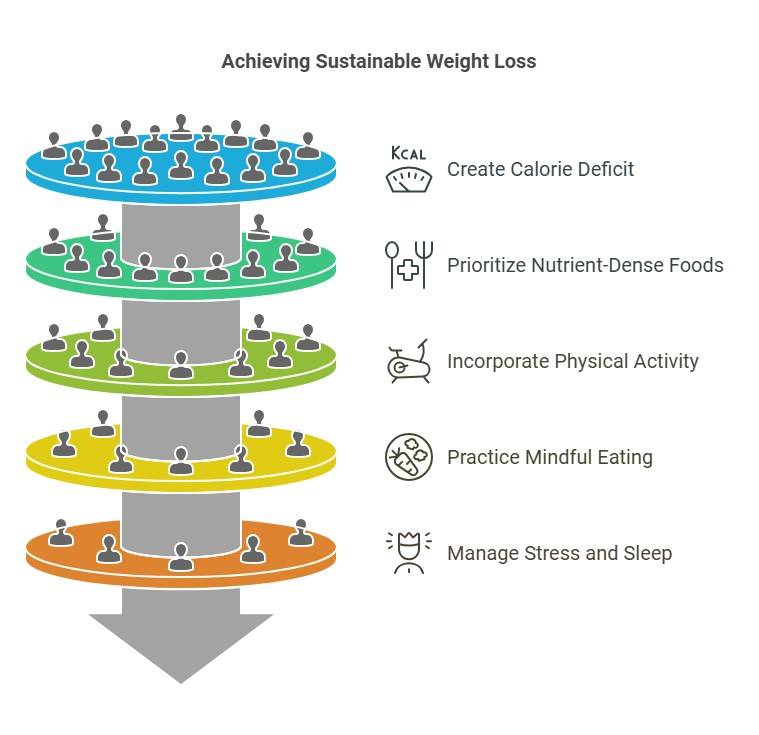Discover 10 proven strategies for lasting weight loss in this comprehensive guide. Unlock the secrets to sustainable results and transform your life. Start your journey now!
Embarking on a weight loss journey is both thrilling and demanding. Lasting results come from real lifestyle changes, not fad diets. In this guide, I’ll share 10 proven strategies for long-term weight loss.
How to Achieve Lasting Weight Loss and Keep It Off

Sustainable weight loss focuses on long-term lifestyle changes, not quick fixes. This guide offers proven strategies to help you lose weight and keep it off for lasting health and success.
1. Set Realistic Goals
The foundation of any successful weight loss plan starts with setting achievable goals. I’ve discovered that striving for big, sudden changes typically results in frustration and exhaustion. Instead, focus on small, incremental steps that add up over time.
For example, when I first started my weight loss journey, I set a goal to lose 1-2 pounds. This modest target allowed me to make steady progress without feeling overwhelmed.
I also set non-scale goals, like being able to jog for 10 minutes without stopping or fitting into a favourite outfit comfortably.
That lasting weight loss is about making steady progress, not achieving perfection. Embrace every small success throughout the journey, as these will help maintain your motivation over time.
2. Create a Moderate Calorie Deficit
One of the most crucial weight loss facts I’ve learned is that creating a calorie deficit is essential for shedding pounds. However, it’s important to approach this strategically.
Drastically cutting calories might lead to quick results, but it’s rarely sustainable and can even your health.
I’ve by aiming for a moderate deficit of about 500 calories per day. This approach allows for steady fat loss of 1-2 pounds per week without leaving you feeling deprived or exhausted. To achieve this, I use a combination of mindful eating and increased physical activity.
For instance, I might swap my usual afternoon snack of chips for a handful of almonds and an apple, saving about 200 calories. Then, I’ll go for a 30-minute brisk walk, burning 150-200 calories. These minor changes add up without feeling like a drastic lifestyle overhaul.
3. Prioritize Nutrient-Dense Foods
Losing weight through healthy eating isn’t about restricting yourself; it’s about fueling your body with the proper nutrients. I’ve discovered that focusing on nutrient-dense options improves overall health and energy levels.
My typical day now includes:
- Plenty of colourful fruits and vegetables
- Lean proteins like chicken, fish, and legumes
- Whole grains such as quinoa and brown rice
- 2-3 strength training workouts targeting the primary muscle groups
By filling my plate with these nutrient-rich foods, I stay satisfied longer and have fewer cravings for less healthy options. It’s not about eliminating food groups but making smarter choices within each category.
4. Incorporate Regular Physical Activity
Exercise for weight loss is a crucial component of any successful weight loss program. However, I’ve learned that it’s not just about burning calories; regular physical activity offers numerous benefits that support long-term success.
I aim for at least 150 minutes of moderate-intensity exercise each week, combining cardio and strength training. Here’s how I break it down:
- Engage in 30 minutes of brisk walking or jogging five days per week.
- Two to three strength workouts targeting the key muscle groups.
I’ve found that mixing up my routine keeps things interesting and challenges my body in different ways. Some days I might go for a swim, while others I’ll try a HIIT workout or a yoga class.
Keep in mind that the most effective workout plan is one you find enjoyable and can maintain regularly. Don’t be afraid to experiment until you find activities you look forward to.
5. Practice Mindful Eating
Practicing mindful eating has significantly transformed my weight loss experience. It’s about being present and fully engaged with your food, rather than mindlessly consuming calories.
Here are some techniques I use:
- Eat slowly and savor each bite
- Pay attention to hunger and fullness cues
- Avoid distractions like TV or phones during meals
- Use smaller plates to help with portion control
- Through mindful eating, I’ve cultivated a more positive and balanced connection with food.
I enjoy my meals more and find it easier to stop eating when I’m satisfied rather than overly full.
6. Prioritize Quality Sleep
A frequently underestimated factor in weight loss is the crucial role of sleep.
I’ve noticed a significant difference in my energy levels and cravings when getting 7-9 hours of quality sleep each night.
Lack of sleep can interfere with hunger hormones, causing a rise in appetite and a desire for calorie-dense foods.
To improve my sleep quality:
- Maintain a regular sleep routine, including on weekends.
- Create a relaxing bedtime routine
- Keep my bedroom cool, dark, and muted
- Limit screen time before bed
These habits have improved my overall well-being and productivity during the day.
7. Manage Stress Effectively
Stress can be a major roadblock in any weight loss journey. I’ve learned that finding healthy ways to manage stress is crucial for long-term success.
Some stress-management techniques I’ve found helpful include:
- Regular meditation or deep breathing exercises
- Engaging in hobbies I enjoy
- Spending time in nature
- Talking to a friend or therapist when needed
By addressing stress in healthier ways, I’ve reduced my tendency to turn to food for comfort, which has been instrumental in maintaining my weight loss.
8. Stay Hydrated
Staying properly hydrated is crucial for both weight loss and overall well-being.
I make it a point to drink at least 8 glasses of water daily, and I’ve noticed several benefits:
- Reduced hunger and cravings
- Improved energy levels
- Better digestion
To ensure I stay hydrated, I carry a reusable water bottle everywhere and set reminders on my phone to drink regularly throughout the day.
9. Track Your Progress
Weight loss tracking has been instrumental in keeping me accountable and motivated. While the scale is one measure of progress, I’ve found it helpful to track other metrics as well:
- Body measurements
- Progress photos
- Fitness achievements (e.g., running distance, weights lifted)
- Energy levels and mood
I use a combination of a journal and a weight loss app to log these details. Seeing my progress, especially during plateaus, helps me stay committed to my goals.
10. Build a Support System
Lastly, having a strong weight loss support system has been crucial to my success. This includes:
- Friends and family who encourage my healthy habits
- A weight loss community online where I can share challenges and victories
- Professional support from a nutritionist and personal trainer
- Don’t hesitate to seek support whenever you require it.
Having people to cheer you on and offer guidance can make all the difference in achieving long-term weight loss.
FAQs about: Lasting Weight Loss
Can you lose 100 pounds in 6 months?
While losing 100 pounds in 6 months is technically possible, it’s not recommended or safe for most people.
A healthy and sustainable rate of weight loss is usually around 1 to 2 pounds per week.
Losing 100 pounds in 6 months would require an extreme calorie deficit and could lead to nutritional deficiencies, muscle loss, and other health issues.
A more realistic and healthy goal would be to aim for 50-60 pounds of weight loss in 6 months, focusing on sustainable lifestyle changes rather than drastic measures
What is the 30/30/30 rule for weight loss?
The 30/30/30 approach is an easy-to-follow weight loss method that includes:
- Consuming 30 grams of protein within the first 30 minutes after waking up.
- Doing 30 minutes of low-intensity, steady-state exercise after breakfast
This approach aims to boost metabolism, increase satiety, and promote fat burning. While there’s limited scientific research specifically on this rule, studies support the benefits of consuming protein at breakfast and regular exercise for weight management.
. However, it’s important to note that this rule should be part of a broader, balanced approach to diet and exercise for lasting weight loss.
What’s the most effective approach to losing weight and maintaining its long-term?
The most effective strategies for lasting weight loss include:
- Creating a moderate calorie deficit (about 500 calories per day)
- Focusing on nutrient-dense, whole foods
- Increasing protein and fiber intake
- Participating in consistent physical activity, such as 150 minutes of moderate weekly exercise.
- Getting adequate sleep (7-9 hours per night)
- Managing stress effectively
- Practicing mindful eating
- Tracking progress and staying accountable
- Making sustainable lifestyle changes rather than following fad diets
10. Building a support system
Remember, successful long-term weight loss is about adopting healthy habits you can maintain over time, rather than pursuing quick fixes or extreme measures.
How can I lose 20 pounds in a month safely?
Losing 20 pounds in a month is not recommended as it’s an unrealistic and dangerous goal for most people. Safe and sustainable weight loss occurs at a rate of 1-2 pounds per week, which means a more realistic goal would be to lose 8-10 pounds in a month.
. To achieve this, focus on:
- Creating a moderate calorie deficit through diet and exercise
- Increasing protein and fiber intake
- Reducing refined carbohydrate consumption
- Incorporating strength training and cardio exercises
- Staying hydrated
- Getting adequate sleep
- Managing stress levels
- Practicing mindful eating
Remember, the key to lasting weight loss is making sustainable lifestyle changes rather than pursuing rapid, short-term results. If you’re worried about your weight or health, .
Conclusion: Embracing a Lifestyle Change
Achieving lasting weight loss is more than following a diet or exercise plan. The key is to implement lasting changes you can sustain over the long term.By implementing these 10 strategies, you’re not just losing weight; you’re creating a healthier, more balanced lifestyle.
Remember, everyone’s weight loss journey is unique. What proves effective for one individual may not be the same for someone else. Be kind to yourself, remain consistent, and tweak your strategy when necessary.
As you progress on your journey, celebrate your successes, learn from your setbacks, and always keep your goal
Recommended Reading



